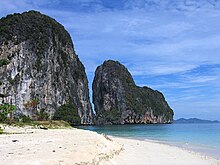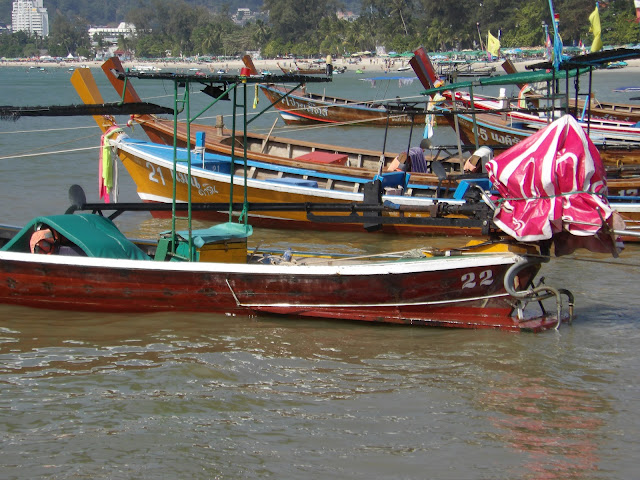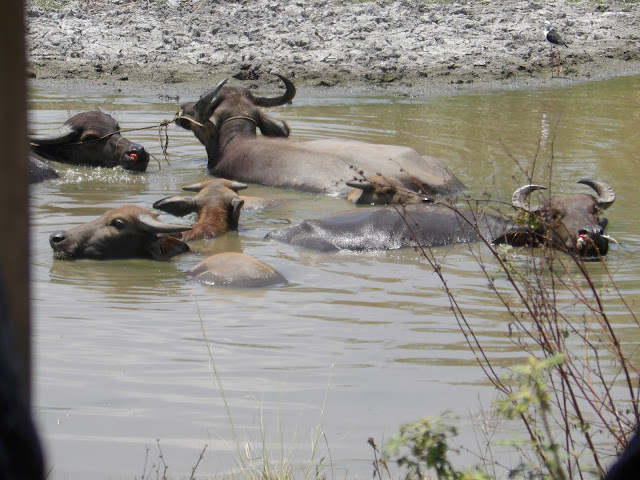Tolin's 2024 World Cruise blog posts, Day 72 Mar 21, 2024, Phuket, Thailand, Thai Life in Bang Rong
Southern Thailand is on the Malay Peninsula, with an area of around 27,303 square miles, bounded to the north by Kra Isthmus, the narrowest part of the peninsula. The western part has highly steep coasts, while on the east side river plains dominate. The largest river of the south is the Tapi in Surat Thani, which together with the Phum Duang in Surat Thani drains more than 3,100 square miles, more than 10 percent of the total area of southern Thailand. Smaller rivers include the Pattani, Saiburi, Krabi, and the Trang. The biggest lake of the south is Songkhla Lake (400 square miles altogether). The largest artificial lake is the Chiao Lan (Ratchaprapha Dam), occupying 64 square miles of Khao Sok National Park in Surat Thani. The total forest area is 6,936 sqare miles or 24.3 percent of provincial area.

Running through the middle of the peninsula are several mountain chains, with the highest elevation at Khao Luang, 6,020 feet, in Nakhon Si Thammarat Province. Ranging from the Kra Isthmus to Phuket Island is the Phuket chain, which connects to the Tanao Si Mountain Range further north. Almost parallel to the Phuket chain, but 60 miles to the east is the Nakhon Si Thammarat or Banthat chain, which begins with Samui Island, Ko Pha Ngan, and Ko Tao in Surat Thani Province and ends at the Malaysian border at the Ko Ta Ru Tao archipelago. The border with Malaysia is formed by the Sankalakhiri range, sometimes sub-divided into the Pattani, Taluban, and Songkhla chain. At the Malaysian border the Titiwangsa chain rises up.
The limestone of the west coast has been eroded into many steep singular hills. The parts submerged by the rising sea after the last ice age now form many islands, like the well-known Phi Phi Islands. Also well known is the so-called James Bond Island in Phang Nga Bay, featured in the movie The Man with the Golden Gun.
The population of the growing region is projected to be 9,156,000 in 2015, up from 8,871,003 in 2010 (census count and adjusted), despite these figures are adjusted for citizens who have left for Bangkok or who have moved to the region from elsewhere, as well as registered permanent residents (residency was problematic in the prior 2000 census), the figure is still misleading. There are still a huge number of migrant or informal workers, temporary workers, and even stateless people, and a large expatriate population which is not included
Most of Southern Thailand is in Tenasserim-South Thailand semi-evergreen rain forests ecoregion. The Peninsular Malaysian rain forests and Peninsular Malaysian montane rain forests ecoregions extend into southernmost Thailand along the border with Malaysia.
https://en.wikipedia.org/wiki/Southern_Thailand
Phuket province, encompassing an area of 222 square miles, ranks as the second-smallest province in Thailand. Its size is comparable to, albeit slightly smaller than, that of Singapore. Historically, Phuket Island was situated on a major trading route between India and China. This strategic location led to its frequent mention in the logs of foreign ships, including those from Portugal, France, the Netherlands, and England. Despite this attention from various European powers, Phuket was never colonized by any European nation.
Economically, the province's wealth was initially derived from tin and rubber production. In more recent times, Phuket has transitioned to tourism as its primary source of income. More than 100,000 foreigners are estimated to have settled in Phuket.
Phuket city is in the southeast corner of Phuket Island, Thailand, and the capital of Phuket province. As of 2020 the city had a population of 79,308. It covers the subdistricts Talat Yai and Talat Nuea of Mueang Phuket district. Phuket is 535.6 miles south of Bangkok.
We began our Bang Rong excursion riding in a local (wooden) "bus"



















































Comments
Post a Comment